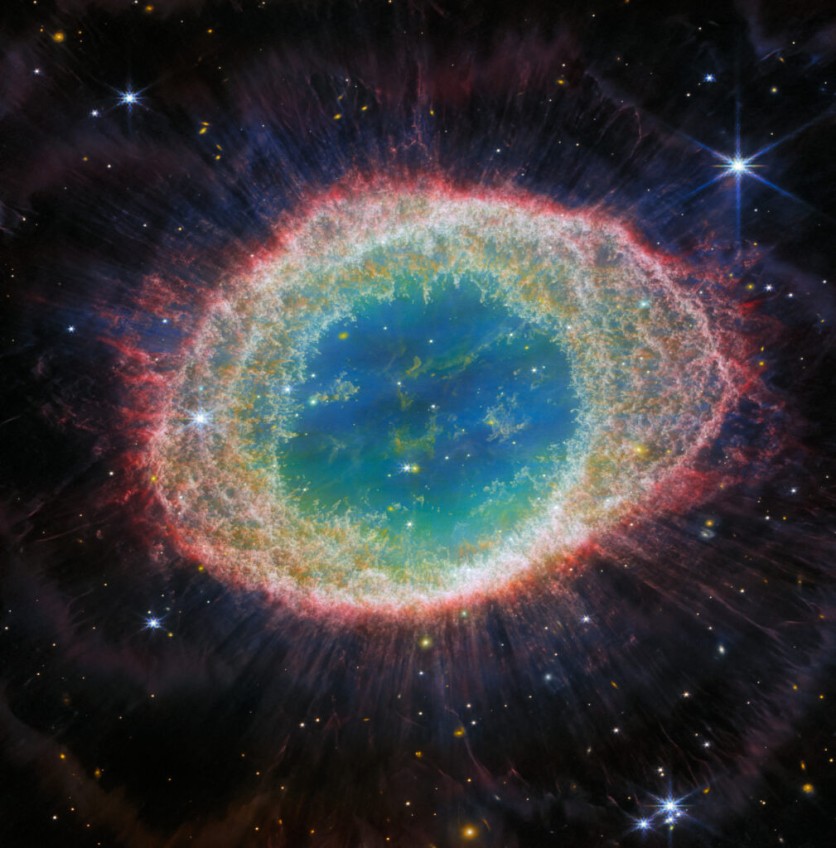NASA's James Webb Space Telescope has unveiled a stunning portrait of the Ring Nebula, a well-known example of a planetary nebula that reveals intricate structures marking the final stages of a dying star's life.
This image follows in the footsteps of the Southern Ring Nebula, one of Webb's initial captures, and offers a mesmerizing glimpse into the cosmic drama of stellar evolution.

Sun-Like Star's Lifecycle
Professor Roger Wesson from Cardiff University sheds light on this captivating phase of a Sun-like star's lifecycle, emphasizing the invaluable insights Webb's observations provide into the genesis and progression of such celestial entities, hinting at the potential role of binary companions in their formation.
Planetary nebulae, once believed to be uncomplicated, spherical formations with a single central dying star were named for their hazy, planet-like appearance when viewed through small telescopes.
According to Wesson, just a few thousand years ago, these planetary nebulae originated from red giants, shedding the bulk of their mass in a final act.
"Only a few thousand years ago, that star was still a red giant that was shedding most of its mass. As a last farewell, the hot core now ionizes, or heats up, this expelled gas, and the nebula responds with colorful emission of light. Modern observations, though, show that most planetary nebulae display breathtaking complexity. It begs the question: how does a spherical star create such intricate and delicate non-spherical structures?" Wesson noted.
The Ring Nebula emerges as a prime candidate for unraveling the enigma of planetary nebulae. Its proximity, approximately 2,200 light-years away, and its visible brightness, even through binoculars on a clear summer night, make it a captivating subject for study.
The ESSENcE (Evolved StarS and their Nebulae in the JWST Era) team, an international group of experts, recognized the Ring Nebula's potential as a Webb target.
The nebula conveniently fits within the field of view of Webb's Near-Infrared Camera (NIRCam) and Mid-Infrared Instrument (MIRI), allowing for unprecedented spatial scrutiny.
The team's proposal to observe the Ring Nebula under the General Observers program 1558 was accepted, resulting in the acquisition of images only a few weeks after Webb's science operations commenced on July 12, 2022.
Inside the Ring Nebula
The luminous ring that gives the nebula its name consists of roughly 20,000 individual clumps of dense molecular hydrogen gas, each comparable in mass to Earth.
Inside the ring, a narrow band of emissions from polycyclic aromatic hydrocarbons (PAHs), intricate carbon-bearing molecules typically not expected to form in the Ring Nebula, makes a curious appearance.
Beyond the bright ring, distinctive "spikes" point outward from the central star. These infrared prominences, faintly visible in Hubble Space Telescope images, are believed to be formed by molecules in the shadowed regions of the ring, shielded from the intense radiation of the central star.
The MIRI images provide a crystalline view of the faint molecular halo encircling the bright ring. An unexpected revelation emerges in the form of concentric features within the halo.
These concentric arcs, occurring approximately every 280 years, signify the shedding of the central star's outer layers. This intriguing pattern suggests the presence of a binary companion, orbiting at a distance similar to that of Pluto from the sun.

![Apple Watch Series 10 [GPS 42mm]](https://d.techtimes.com/en/full/453899/apple-watch-series-10-gps-42mm.jpg?w=184&h=103&f=9fb3c2ea2db928c663d1d2eadbcb3e52)



